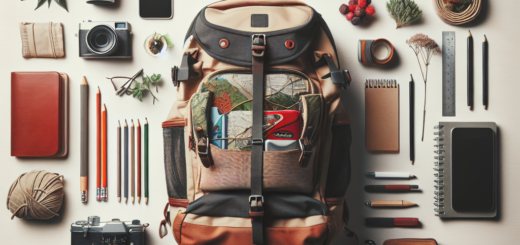The Best Hiking Tips For Beginners

Are you a beginner hiker itching to hit the trails but feeling a bit overwhelmed? Look no further. “The Best Hiking Tips For Beginners” is your go-to resource for all things hiking. Packed with valuable advice and insider knowledge, this ultimate guide has everything you need to know before embarking on your outdoor adventure. Whether you’re planning a leisurely nature walk or a challenging trek through rugged terrain, these tips and tricks will ensure you have a safe and enjoyable hiking experience. So grab your backpack, lace up your boots, and get ready to explore the great outdoors like a pro!
Choosing the Right Trail
Consider your fitness level
When choosing a hiking trail, it’s important to consider your fitness level. If you’re just starting out, it’s best to choose trails that are suitable for beginners. Look for trails that are labeled as “easy” or “moderate” in difficulty. These trails will typically have a moderate incline and well-maintained paths, making them a good choice for those who are new to hiking or have a lower fitness level.
Start with easy or moderate trails
Starting with easy or moderate trails allows you to gradually build up your endurance and strength. These trails are usually less strenuous and will give you a chance to familiarize yourself with the basics of hiking without pushing yourself too hard. As you build up your fitness level and gain more experience, you can gradually tackle more challenging trails.
Research the trail difficulty and conditions
Before embarking on a hike, it’s important to research the trail difficulty and conditions. This information can usually be found online or in hiking guidebooks. Pay attention to the length of the trail, elevation gain, and any potential hazards such as steep drop-offs or slippery sections. By knowing what to expect, you can better prepare yourself mentally and physically for the hike ahead.
Check for any trail closures or restrictions
To ensure a safe and enjoyable experience, always check for any trail closures or restrictions before heading out. This information can be obtained from park websites, visitor centers, or local hiking groups. Trail closures may occur due to weather conditions, maintenance work, or wildlife concerns. It’s important to respect these closures and choose an alternative trail for your hike. By staying informed, you can avoid any disappointment or potential danger during your hiking adventure.
Preparing for the Hike
Check the weather forecast
One of the most important aspects of preparing for a hike is checking the weather forecast. Weather conditions can greatly impact your hiking experience and safety. Make sure to check the forecast for the specific area where you will be hiking, as weather can vary greatly between regions. Be prepared for changes in weather throughout the day and pack accordingly.
Pack essential gear and equipment
Before setting off on your hike, it’s crucial to pack essential gear and equipment. This includes items such as a backpack, map, compass or GPS device, first aid kit, headlamp or flashlight, extra food and water, and appropriate clothing layers. Pack items that are necessary for the duration and difficulty of your hike. It’s also important to consider the weight of your backpack and only carry what you truly need.
Dress in layers
Dressing in layers is key to staying comfortable and protected during your hike. This allows you to easily adjust your clothing to changing weather conditions and your body temperature. Start with a moisture-wicking base layer to keep you dry, add a insulating layer for warmth, and finish with a waterproof and breathable outer layer to protect against wind and rain. Don’t forget to wear a hat, sunglasses, and sunscreen for sun protection.
Wear appropriate footwear
Choosing the right footwear for hiking is essential for comfort and safety. Invest in a pair of hiking boots or shoes that provide good traction, ankle support, and are comfortable for long walks. It’s important to break in your footwear before your hike to prevent blisters and discomfort. Wear moisture-wicking socks that help prevent blisters and choose socks made from synthetic or wool materials, as they dry quickly and maintain insulation even when wet.
Safety Precautions
Inform someone about your hiking plans
Before heading out on a hike, always inform someone about your hiking plans. Share details such as the trail you will be hiking, your estimated time of return, and any emergency contacts. This is crucial in case something goes wrong and you need assistance. If possible, consider hiking with a friend or joining a hiking group for added safety.
Bring a map, compass, and/or GPS
When venturing into the wilderness, always bring a map, compass, and/or GPS device. These tools will help you navigate and stay on the right track. Familiarize yourself with how to use them before your hike, as relying solely on technology may not always be possible or reliable. A map and compass can be useful if your GPS device loses its signal or runs out of battery.
Stay on marked trails
While it may be tempting to explore off-trail, it’s important to stay on marked trails for your safety and the preservation of the environment. Marked trails are maintained and designed to prevent erosion and protect sensitive habitats. Venturing off-trail can increase the risk of getting lost, damaging fragile ecosystems, and disturbing wildlife. Follow trail markers and signs to ensure you’re on the right path.
Be aware of wildlife and take necessary precautions
When hiking in the wilderness, it’s important to be aware of wildlife and take necessary precautions. Research the specific wildlife that may be present in the area where you will be hiking and learn how to act in their presence. Keep a safe distance, never feed or approach wild animals, and store your food and scented items securely to prevent attracting them. Be prepared for encounters and carry items such as bear spray if necessary.
Stay hydrated and bring enough water
Staying hydrated is essential for a safe and enjoyable hike. Dehydration can lead to fatigue, dizziness, and even serious health issues. Before starting your hike, make sure to drink plenty of water and carry enough for your entire hike. The amount of water needed will depend on the length and difficulty of the hike, as well as the weather conditions. Remember to drink regularly during your hike to keep hydrated.
Proper Hiking Technique
Maintain a steady pace
Maintaining a steady pace is crucial for conserving energy and preventing exhaustion during your hike. Find a comfortable rhythm and pace yourself. It’s better to maintain a slower pace and keep going than to start too fast and become fatigued quickly. Remember, hiking is not a race, and it’s important to enjoy the journey rather than rushing to reach the destination.
Take frequent breaks
Taking frequent breaks is important for resting, hydrating, and refueling during your hike. Find scenic spots or comfortable resting areas along the trail to sit down, stretch your muscles, and enjoy the surrounding nature. Use these breaks to rehydrate, eat snacks or meals, and assess your energy levels. Listen to your body and take breaks as needed to prevent exhaustion.
Use proper body posture
Using proper body posture while hiking can help prevent injuries and fatigue. Keep your back straight and your shoulders relaxed. Use your abdominal muscles to support your core and maintain stability. Bend your knees slightly to absorb impact when going downhill and engage your glutes and quadriceps muscles to power up steep inclines. Be mindful of your body posture throughout your hike to maintain efficiency and prevent strain.
Take care of your feet
Your feet are your most important asset when hiking, so it’s vital to take care of them. Keep your feet clean and dry, especially if you encounter streams or wet terrain. Wear properly fitting and comfortable footwear to prevent blisters and hot spots. Consider using blister prevention products, such as moleskin or blister patches, and bring spare socks to change into if needed. Stop and address any foot discomfort immediately to prevent further issues.
Use hiking poles if necessary
Hiking poles can provide stability and support, especially on challenging terrain. They can help distribute your weight, reduce strain on your joints, and provide better balance. Consider using hiking poles if you have knee or joint issues, are hiking on uneven terrain, or carrying a heavy backpack. Adjust the length of your poles so that your arms are at a comfortable angle when holding them.
Navigation and Orientation
Learn how to read a map and use a compass
Learning how to read a map and use a compass are essential skills for navigating while hiking. Familiarize yourself with the symbols and features on a topographic map, and practice using a compass to determine your direction and orient the map. Understanding how to interpret contour lines and measure distances will help you navigate accurately and stay on course.
Pay attention to trail markers and signs
Trail markers and signs are crucial for staying on the right path while hiking. Pay attention to the colors, shapes, and symbols used on the markers, as they can provide important information about the trail. Follow the signs and markers closely, and be mindful of any junctions or intersections that may require a change in direction. If you’re unsure about the route, consult your map or seek assistance from experienced hikers or park rangers.
Practice basic navigation skills
Practicing basic navigation skills is important to build confidence and competence while hiking. Start by familiarizing yourself with your surroundings and noting landmarks along the trail. Practice estimating distances, orienteering without a compass, and identifying different features on the landscape. By sharpening your navigation skills, you can enhance your hiking experience and be better prepared for unexpected situations.
Have a backup plan
Even with careful planning and preparation, things may not always go as expected during a hike. It’s important to have a backup plan in case of unforeseen circumstances, such as trail closures, extreme weather, or fatigue. Familiarize yourself with alternative routes or exit points along the trail, and carry a map or guidebook that includes this information. Having a backup plan can help you make informed decisions and adapt to changing situations.
Basic Wilderness Survival Skills
Build a basic shelter
Knowing how to build a basic shelter is an essential skill for wilderness survival. This can provide protection from the elements and keep you warm during an unexpected overnight stay. Look for natural materials such as fallen branches, leaves, or rocks to construct a shelter. Insulate the ground with soft vegetation and create a roof or lean-to structure to shield yourself from rain or wind. Practice building shelters in different environments to gain confidence in this important survival skill.
Start a fire and know fire safety
Starting a fire can provide warmth, light, and a means to cook food in a wilderness survival situation. Learn how to safely build a fire using the appropriate materials, such as dry leaves, twigs, and small branches. Carry fire-starting tools, such as waterproof matches or a fire starter, and practice fire safety by keeping the fire contained and extinguishing it completely before leaving. Always follow local regulations and restrictions regarding fire use.
Find and purify water
Finding and purifying water is crucial for survival in the wilderness. Learn how to identify potential water sources, such as streams, lakes, or natural springs. Use a water filter, purification tablets, or boil water to remove harmful bacteria and parasites. Carry a sufficient amount of water or a water bottle with a built-in filter to ensure a constant supply. Be cautious of stagnant or contaminated water sources and prioritize purification for your health and safety.
Identify edible plants and berries
Knowing how to identify edible plants and berries can supplement your food supply in a survival situation. Research and familiarize yourself with edible plants found in the area where you will be hiking. Learn to identify common edible plants, such as wild berries, edible mushrooms, or edible wild greens. It’s essential to be certain of the plant’s identity before consuming it, as some plants can be toxic or cause allergic reactions. If in doubt, it’s best to avoid eating unknown plants.
Know basic first aid
Having knowledge of basic first aid is essential for treating minor injuries and providing initial care in the wilderness. Take a first aid course or familiarize yourself with basics such as wound cleaning, bandaging techniques, splinting, and CPR. Carry a first aid kit with essential supplies tailored to your hiking needs. Be aware of potential hazards, such as sprains, cuts, and insect bites, and know how to treat them promptly to prevent further complications.
Leave No Trace Principles
Pack out what you pack in
As a responsible hiker, it’s important to follow the principle of “pack out what you pack in.” This means that any waste or trash you bring with you on your hike should be carried back out. Use proper disposal methods for waste and refrain from leaving anything behind, including food scraps, wrappers, or toilet paper. Leaving no trace helps preserve the natural beauty of the environment and ensures a healthy ecosystem for future generations.
Minimize campfire impacts
If you plan on having a campfire during your hike, it’s essential to minimize its impact on the environment. Choose designated fire rings or fire areas when available and use existing fire pits to prevent further damage. Use only dead and downed wood as fuel and avoid collecting wood from live or standing trees. Make sure to fully extinguish the fire and leave no trace of your presence by dispersing ashes and covering the fire pit with soil.
Dispose of waste properly
Proper waste disposal is crucial to maintain a clean and healthy environment while hiking. Carry a suitable system for disposing of human waste, such as a portable toilet system or zip-top bags for packing out waste. If there are no designated facilities, find a location at least 200 feet away from water sources, trails, and campgrounds. Dig a small hole at least six inches deep for solid waste and bury it properly. Urinate away from water sources and trails, and use biodegradable soap for washing.
Respect wildlife and nature
While hiking, it’s important to respect wildlife and the natural environment. Observe animals from a safe distance and refrain from feeding or approaching them. Maintain a respectful distance to prevent causing stress or disturbance to the wildlife. Avoid touching or removing any natural objects or artifacts, as they have an important role in the ecosystem. By respecting wildlife and nature, you can help preserve the natural balance and habitats of the area.
Leave natural and cultural objects undisturbed
As you hike through nature, it’s crucial to leave natural and cultural objects undisturbed. This includes leaving rocks, plants, tree bark, and historical artifacts in their natural place. Disturbing or removing these objects can disrupt ecosystems, harm delicate species, and erase traces of human history. Appreciate and admire the beauty of these objects without causing any harm or disturbance.
Fitness and Conditioning
Begin a regular exercise routine
To prepare yourself physically for hiking, it’s important to begin a regular exercise routine. Cardiovascular exercises such as walking, jogging, cycling, or swimming can help improve your endurance and stamina. Incorporate strength training exercises to build the necessary muscle strength for hiking. Aim for at least 30 minutes of exercise most days of the week to gradually build your fitness level.
Focus on cardiovascular endurance
Hiking requires good cardiovascular endurance to handle sustained physical activity for extended periods of time. Engage in activities that elevate your heart rate, such as brisk walking or cycling, to improve your cardiovascular fitness. Gradually increase the intensity and duration of your workouts to build endurance over time. This will help you tackle longer and more challenging hikes with ease.
Strengthen your lower body muscles
Strengthening your lower body muscles is crucial for hiking, as it involves walking uphill, downhill, and over uneven terrain. Incorporate exercises that target your quadriceps, hamstrings, glutes, and calves, such as squats, lunges, step-ups, and calf raises. Include both bodyweight exercises and resistance training using weights or resistance bands to build strength and stability.
Incorporate hikes into your training
The best way to prepare for hiking is to actually hike! Incorporate regular hikes into your training routine to simulate the physical demands of hiking. Start with shorter and easier hikes, gradually increasing the length and difficulty level as you progress. This will help acclimate your body to the specific movements and challenges of hiking and build your confidence in tackling longer trails.
Proper Backpacking Techniques
Pack your backpack efficiently
Packing your backpack efficiently is essential for comfort and accessibility while hiking. Place heavy items at the bottom and towards the center of your backpack to keep the weight centered and balanced. Pack lighter items towards the top and distribute the weight evenly on both sides. Use compartments and packing cubes to organize your gear and prevent it from shifting during your hike.
Distribute weight evenly
Distributing weight evenly in your backpack is crucial for maintaining balance and preventing strain on your body. Adjust the straps and hip belt of your backpack to ensure a comfortable and secure fit. The majority of the weight should be supported by your hips rather than your shoulders. Take the time to adjust and readjust as needed to find the optimal weight distribution for your body.
Adjust and secure straps for comfort
Properly adjusting and securing the straps of your backpack is important for comfort and preventing unnecessary strain. The shoulder straps should be snug but not too tight, with enough room to move your arms freely. Adjust the hip belt so that it rests comfortably on your hips, taking the weight off your shoulders. The sternum strap can help distribute weight and stabilize the backpack. Make adjustments as needed throughout your hike to maintain comfort.
Use a backpack rain cover
Weather conditions can change quickly during a hike, and it’s important to protect your gear from rain and moisture. Use a backpack rain cover to keep your backpack and its contents dry. Rain covers are lightweight and easy to pack, and they can be quickly deployed when needed. Make sure to choose a rain cover that is specifically designed for your backpack size to ensure a proper fit and maximum protection.
Organize essentials for easy access
Organizing your essential gear and equipment for easy access can save you time and hassle during your hike. Keep frequently used items, such as snacks, water bottles, maps, and navigation tools, in easily accessible pockets or compartments. Pack emergency items, such as a first aid kit or a headlamp, in a designated area that you can quickly locate. Organizing your gear will help streamline your hiking experience and ensure you have everything you need at your fingertips.
Mindset and Mental Preparation
Set realistic expectations
When embarking on a hike, it’s important to set realistic expectations for yourself. Consider the difficulty level, length, and conditions of the trail, as well as your own fitness level and hiking experience. Understand that hiking can be physically and mentally challenging at times, but also rewarding. By setting realistic expectations, you can better gauge your abilities, celebrate your achievements, and be prepared for any difficulties along the way.
Stay positive and embrace challenges
Maintaining a positive mindset is crucial for a successful hiking experience. Embrace challenges as opportunities for growth and learning. Keep a positive attitude when facing obstacles or difficult sections of the trail. Remember that the journey is just as important as the destination, and each step brings you closer to your goal. Appreciate the beauty of nature around you and be grateful for the opportunity to explore the great outdoors.
Practice mindful hiking
Mindful hiking involves being fully present and engaged in the hiking experience. Take the time to observe the sights, sounds, and smells of nature around you. Engage your senses and tune in to the present moment. Breathe deeply and connect with your surroundings. Leave behind distractions and worries, and allow yourself to fully immerse in the beauty and tranquility of nature. Mindful hiking can enhance your overall well-being and bring a deeper sense of enjoyment to your hike.
Build mental resilience
Hiking can test your mental strength and resilience, especially during challenging sections or unexpected hurdles. Build mental resilience by embracing discomfort and pushing through difficult moments. Develop a growth mindset and focus on the positive aspects of your hike. Practice positive self-talk and remind yourself of your abilities and past successes. By building mental resilience, you can overcome obstacles, stay motivated, and fully enjoy the rewards that come with hiking.
Enjoy the journey
Above all, remember to enjoy the journey. Hiking is not just about reaching the summit or completing a trail; it’s about immersing yourself in nature, connecting with your body and mind, and discovering new places. Take the time to appreciate the beauty and serenity of the natural world. Pause to enjoy breathtaking views, listen to the sounds of wildlife, and capture the moments through photography or journaling. Cherish the memories and moments that make hiking a truly enriching experience.



